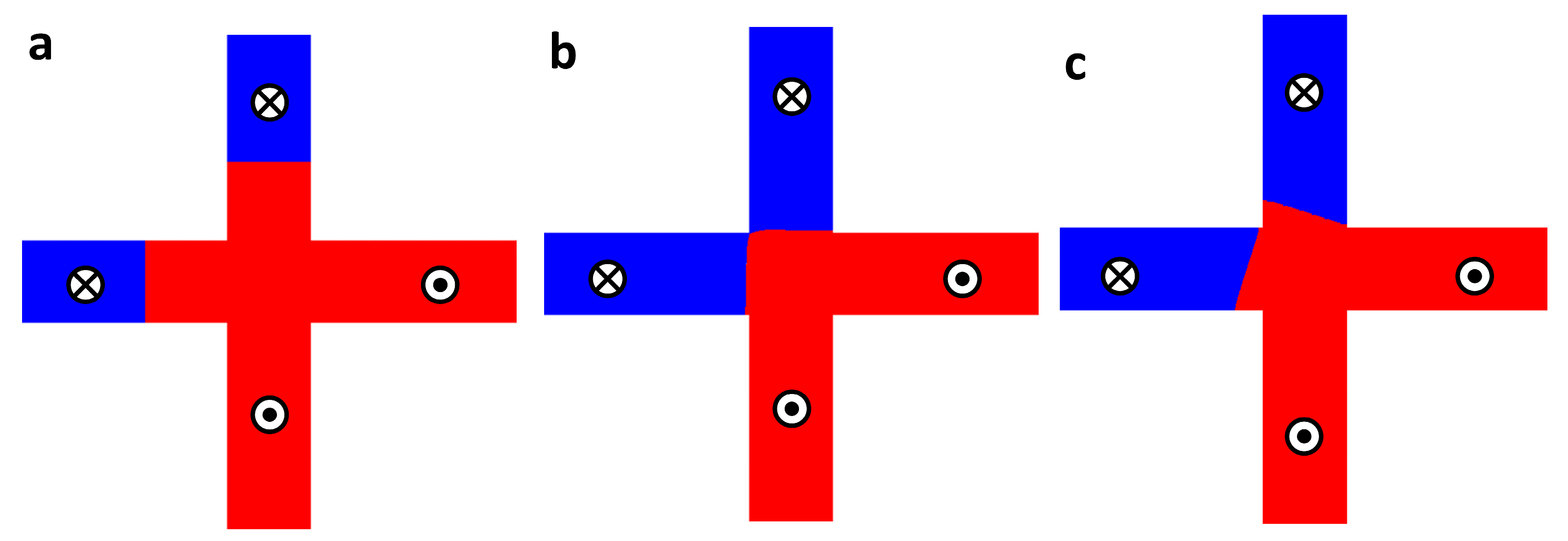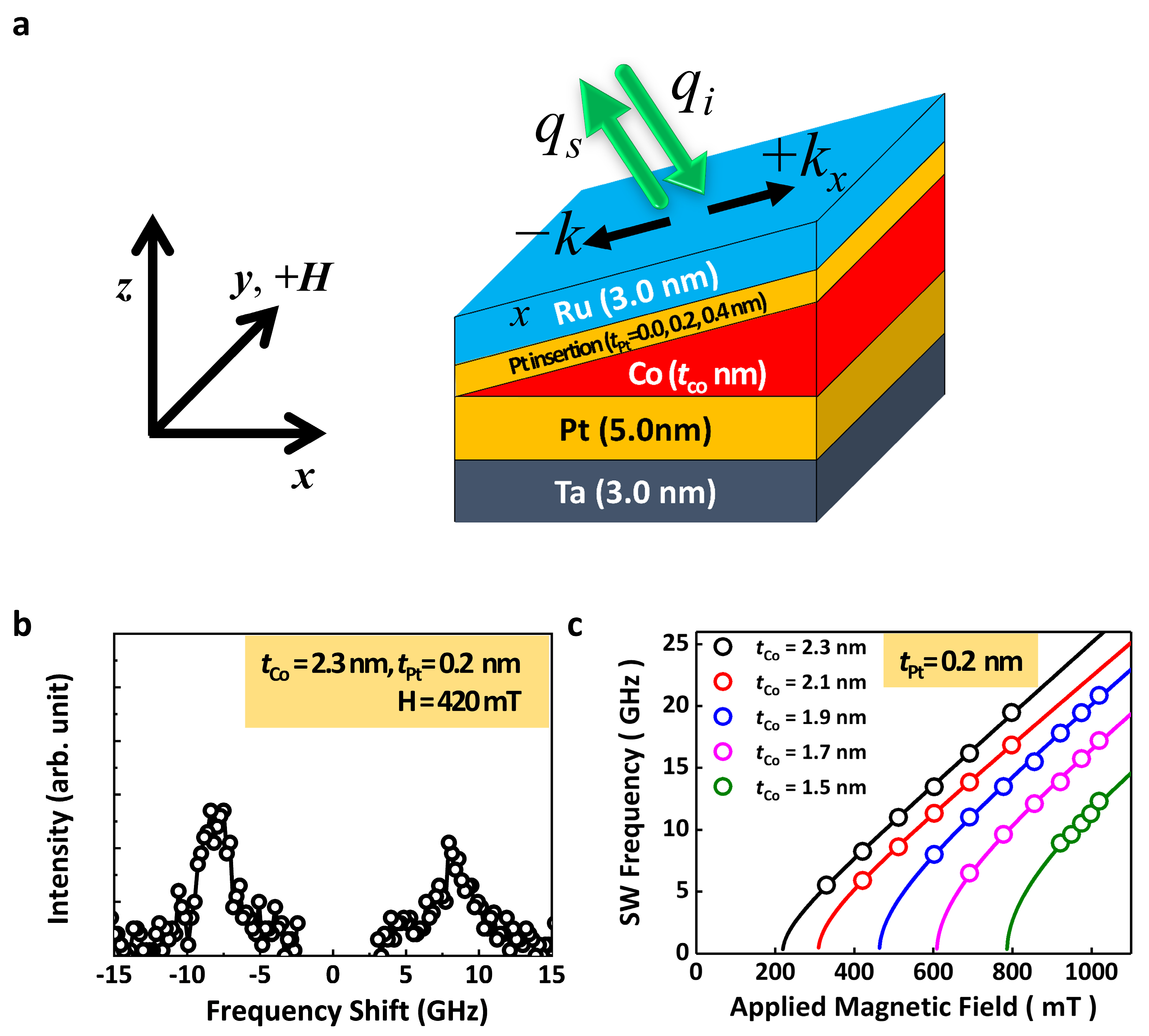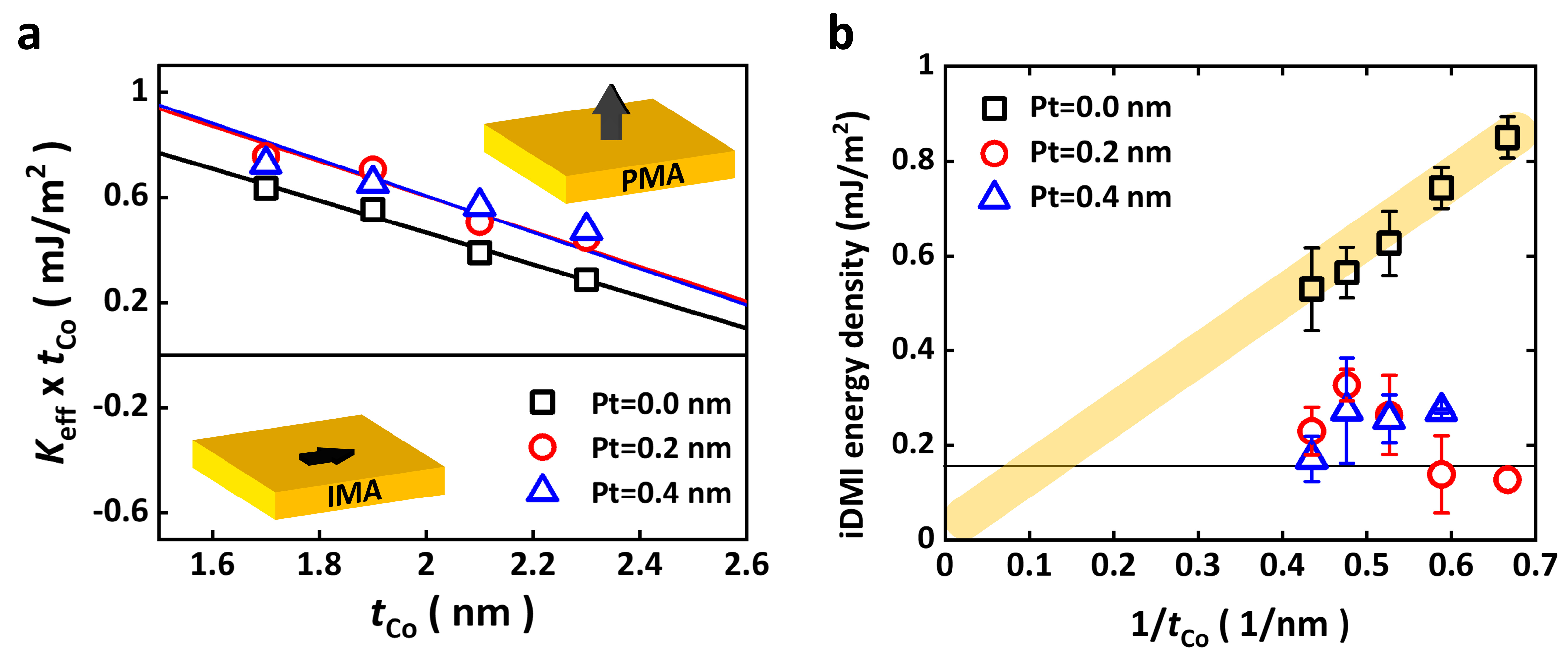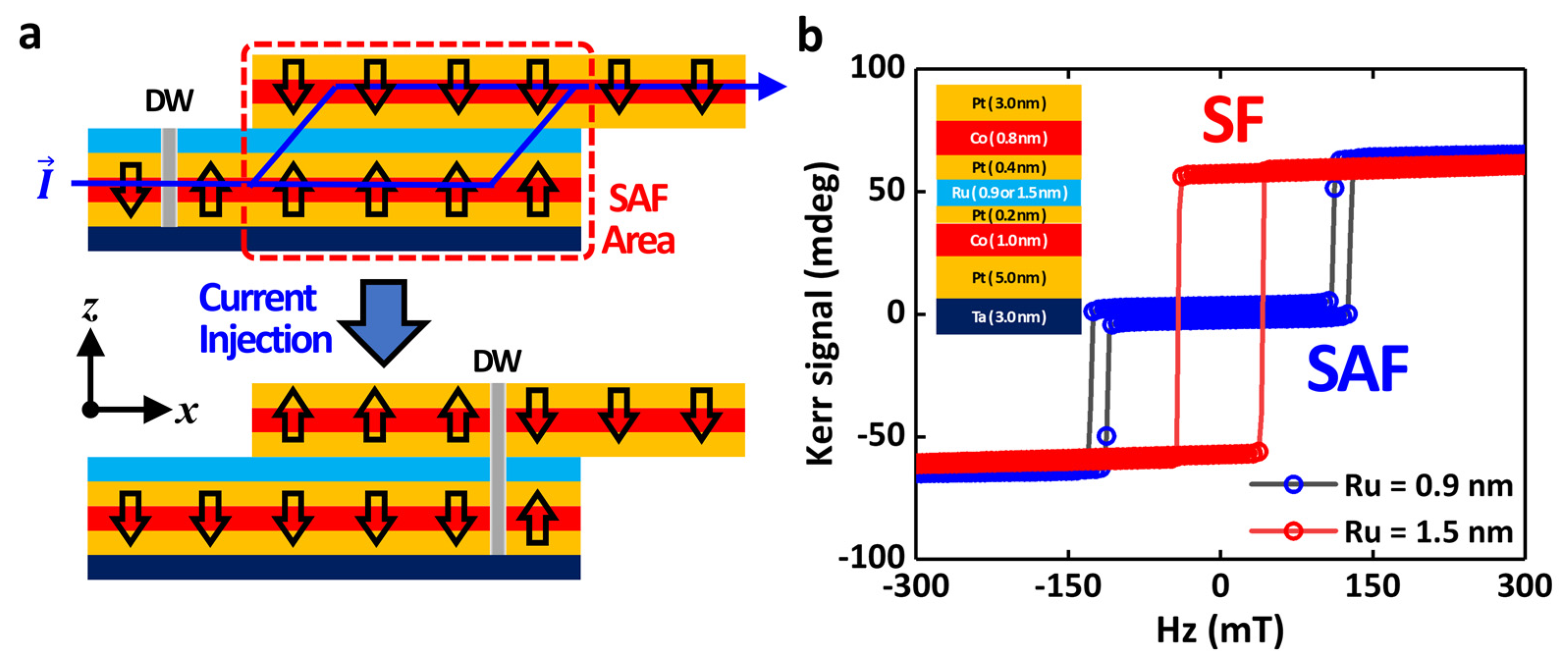The Stack Optimization of Magnetic Heterojunction Structures for Next-Generation Spintronic Logic Applications
Abstract
:1. Introduction
2. Materials and Methods
3. Results and Discussion
3.1. Micromagnetic Simulations
3.2. Magnetic Properties
3.3. Interlayer Exchange Coupling
4. Conclusions
Author Contributions
Funding
Institutional Review Board Statement
Informed Consent Statement
Data Availability Statement
Conflicts of Interest
References
- Johnson, M.T.; Bloemen, P.J.H.; den Broeder, F.J.A.; de Vries, J.J. Magnetic anisotropy in metallic multilayers. Rep. Prog. Phys. 1996, 59, 1409. [Google Scholar] [CrossRef]
- Yang, H.; Thiaville, A.; Rohart, S.; Fert, A.; Chshiev, M. Anatomy of Dzyaloshinskii-Moriya Interaction at Co/Pt Interfaces. Phys. Rev. Lett. 2015, 115, 267210. [Google Scholar] [CrossRef]
- Kim, D.-O.; Song, K.M.; Choi, Y.; Min, B.-C.; Kim, J.-S.; Choi, J.-W.; Lee, D.R. Asymmetric magnetic proximity effect in a Pd/Co/Pd trilayer system. Sci. Rep. 2016, 6, 25391. [Google Scholar] [CrossRef] [PubMed]
- Jungwirth, T.; Marti, X.; Wadley, P.; Wunderlich, J. Antiferromagnetic spintronics. Nat. Nanotechnol. 2016, 11, 231–241. [Google Scholar] [CrossRef] [PubMed]
- Dieny, B.; Prejbeanu, I.L.; Garello, K.; Gambardella, P.; Freitas, P.; Lehndorff, R.; Raberg, W.; Ebels, U.; Demokritov, S.O.; Akerman, J.; et al. Opportunities and challenges for spintronics in the microelectronics industry. Nat. Electron. 2020, 3, 446–459. [Google Scholar] [CrossRef]
- Finocchio, G.; Büttner, F.; Tomasello, R.; Carpentieri, M.; Kläui, M. Magnetic Skyrmions: From Fundamental to Applications. J. Phys. D Appl. Phys. 2016, 49, 423001. [Google Scholar] [CrossRef]
- Fert, A.; Cros, V.; Sampaio, J. Skyrmions on the Track. Nat. Nanotechnol. 2013, 8, 152–156. [Google Scholar] [CrossRef]
- Büttner, F.; Lemesh, I.; Beach, G.S.D. Theory of isolated magnetic skyrmions: From fundamentals to room temperature applications. Sci. Rep. 2018, 8, 4464. [Google Scholar] [CrossRef]
- Gnoli, L.; Riente, F.; Vacca, M.; Roch, M.R.; Graziano, M. Skyrmion Logic-In-Memory Architecture for Maximum/Minimum Search. Electronics 2021, 10, 155. [Google Scholar] [CrossRef]
- Romming, N.; Hanneken, C.; Menzel, M.; Bickel, J.E.; Wolter, B.; von Bergmann, K.; Kubetzka, A.; Wiesendanger, R. Writing and Deleting Single Magnetic Skyrmions. Science 2013, 341, 636–639. [Google Scholar] [CrossRef]
- Liu, S.; Wang, G.; Bai, T.; Mo, K.; Chen, J.; Mao, W.; Wang, W.; Yuan, Z.; Pan, B. Magnetic Skyrmion-Based Spiking Neural Network for Pattern Recognition. Appl. Sci. 2022, 12, 9698. [Google Scholar] [CrossRef]
- Luo, Z.; Hrabec, A.; Dao, T.P.; Sala, G.; Finizio, S.; Feng, J.; Mayr, S.; Raabe, J.; Gambardella, P.; Heyderman, L.J. Current-driven magnetic domain-wall logic. Nature 2020, 579, 214–218. [Google Scholar] [CrossRef] [PubMed]
- Grollier, J.; Querlioz, D.; Stiles, M.D. Spintronic nanodevices for bioinspired computing. Proc. IEEE 2016, 104, 2024–2039. [Google Scholar] [CrossRef] [PubMed]
- Lin, J.Q.; Chen, J.P.; Tan, Z.Y.; Chen, Y.; Chen, Z.F.; Li, W.A.; Gao, X.S.; Liu, J.M. Manipulation of Skyrmion Motion Dynamics for Logical Device Application Mediated by Inhomogeneous Magnetic Anisotropy. Nanomaterials 2022, 12, 278. [Google Scholar] [CrossRef]
- Nikonov, D.E.; Bourianoff, G.I.; Ghani, T. Proposal of a Spin Torque Majority Gate Logic. IEEE Electron Device Lett. 2011, 32, 1128–1130. [Google Scholar] [CrossRef]
- Lee, G.-H.; Kim, K.-J. Optimizing the Geometry of Chiral Magnetic Logic Devices. J. Magn. 2020, 25, 150–156. [Google Scholar] [CrossRef]
- Boulle, O.; Rohart, S.; Buda-Prejbeanu, L.D.; Jue, E.; Miron, I.M.; Pizzini, S.; Vogel, J.; Gaudin, G.; Thiaville, A. Domain Wall Tilting in the Presence of the Dzyaloshinskii-Moriya Interaction in Out-of-Plane Magnetized Magnetic Nanotracks. Phys. Rev. Lett. 2013, 111, 217203. [Google Scholar] [CrossRef]
- Sandercock, J.R. Light Scattering in Solids III; Cardona, M., Guntherodt, G., Eds.; Springer: Berlin/Heidelberg, Germany, 1982; p. 173. [Google Scholar]
- Vansteenkiste, A.; Leliaert, J.; Dvornik, M.; Helsen, M.; Garcia-Sanchez, F.; VanWaeyenberge, B. The design and verification of MuMax3. AIP Adv. 2014, 4, 107133. [Google Scholar] [CrossRef]
- Jung, J.; Cho, J.; Choi, H.-C.; Lee, K.; You, C.-Y.; Choe, S.-B.; Kim, J.-S. Modulations of interfacial magnetic properties using structurally inverted magnetic tri-layer systems: Toward skyrmion formation. Appl. Phys. Lett. 2021, 118, 262408. [Google Scholar] [CrossRef]
- Cho, J.; Kim, N.-H.; Lee, S.; Kim, J.-S.; Lavrijsen, R.; Solignac, A.; Yin, Y.; Han, D.-S.; van Hoof, N.J.J.; Swagten, H.J.M.; et al. Thickness dependence of the interfacial Dzyaloshinskii–Moriya interaction in inversion symmetry broken systems. Nat. Commun. 2015, 6, 7635. [Google Scholar] [CrossRef]
- Kim, N.-H.; Han, D.-S.; Jung, D.; Park, K.; Swagten, H.J.M.; Kim, J.-S.; You, C.-Y. Dependence of interfacial Dzyaloshinskii–Moriya interaction and perpendicular magnetic anisotropy on the thickness of the heavy-metal layer. Appl. Phys. Express 2017, 10, 103003. [Google Scholar] [CrossRef]
- Cho, J.; Lee, C.-K.; Kim, J.; Kim, J.-S.; You, C.-Y. The sign of the interfacial Dzyaloshinskii–Moriya interaction in ultrathin amorphous and polycrystalline magnetic films. J. Phys. D Appl. Phys. 2022, 55, 435008. [Google Scholar] [CrossRef]
- Jung, J.; Kim, J.-S.; Kim, J.; Cho, J.; You, C.-Y. Enhancement of Brillouin light scattering signal with anti-reflection layers on magnetic thin films. J. Magn. Magn. Mater. 2020, 502, 1666565. [Google Scholar] [CrossRef]
- Je, S.G.; Kim, D.H.; Yoo, S.C.; Min, B.C.; Lee, K.J.; Choe, S.B. Asymmetric magnetic domain-wall motion by the Dzyaloshinskii-Moriya interaction. Phys. Rev. B 2013, 88, 214401. [Google Scholar] [CrossRef]
- Park, Y.-K.; Kim, D.-Y.; Kim, J.-S.; Nam, Y.-S.; Park, M.-H.; Choi, H.-C.; Min, B.-C.; Choe, S.-B. Experimental observation of the correlation between the interfacial Dzyaloshinskii–Moriya interaction and work function in metallic magnetic trilayers. NPG Asia Mater. 2018, 10, 995–1001. [Google Scholar] [CrossRef]





| Pt = 0.0 nm | Pt = 0.2 nm | Pt = 0.4 nm | |
|---|---|---|---|
| Ms (k/Am) | 982 ± 47 | 1029 ± 28 | 1049 ± 33 |
| Ks (m/Jm2) | 0.84 ± 0.01 | 0.97 ± 0.02 | 0.99 ± 0.03 |
| Ds (p/Jm) | 1.23 ± 0.04 | 0.43 ± 0.19 | 0.48 ± 0.06 |
Disclaimer/Publisher’s Note: The statements, opinions and data contained in all publications are solely those of the individual author(s) and contributor(s) and not of MDPI and/or the editor(s). MDPI and/or the editor(s) disclaim responsibility for any injury to people or property resulting from any ideas, methods, instructions or products referred to in the content. |
© 2023 by the authors. Licensee MDPI, Basel, Switzerland. This article is an open access article distributed under the terms and conditions of the Creative Commons Attribution (CC BY) license (https://creativecommons.org/licenses/by/4.0/).
Share and Cite
Cho, J.; Jung, J.; Kim, S.B.; Ju, W.R.; Kim, D.H.; Byun, M.; Kim, J.-S. The Stack Optimization of Magnetic Heterojunction Structures for Next-Generation Spintronic Logic Applications. Materials 2023, 16, 6418. https://doi.org/10.3390/ma16196418
Cho J, Jung J, Kim SB, Ju WR, Kim DH, Byun M, Kim J-S. The Stack Optimization of Magnetic Heterojunction Structures for Next-Generation Spintronic Logic Applications. Materials. 2023; 16(19):6418. https://doi.org/10.3390/ma16196418
Chicago/Turabian StyleCho, Jaehun, Jinyong Jung, Seong Bok Kim, Woo Ri Ju, Da Hyeon Kim, Myunghwan Byun, and June-Seo Kim. 2023. "The Stack Optimization of Magnetic Heterojunction Structures for Next-Generation Spintronic Logic Applications" Materials 16, no. 19: 6418. https://doi.org/10.3390/ma16196418






